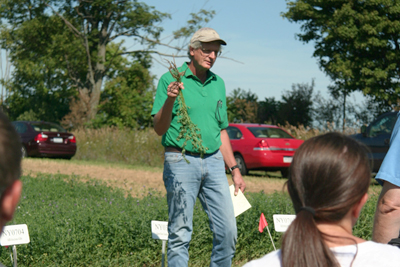Shields' method to control nasty pest reaps award
By Kara Lynn Dunn

Entomologist Elson Shields, who spearheaded the development of a biocontrol practice for controlling alfalfa snout beetle (ASB), will receive the Entomological Foundation Award for Excellence in IPM in March at the Entomological Society of America meeting.
New York farmers are now adopting his effective and inexpensive way to control ASB, which can destroy an entire field of valuable dairy and livestock forage in one season.
Shields, professor of entomology, conducted the foundational research into ASB, investigated potential control measures, designed a new greenhouse screening method, field-tested that protocol and developed an easy-to-implement on-farm biocontrol protocol that uses nematodes native to New York to destroy the larvae of the ASB.
His methods are summarized in the new seven-page "Management of Alfalfa Snout Beetle" primer, which farmers in the New York are receiving at agricultural events.
The primer includes calculations of the cost of losing an alfalfa crop to ASB, which can be as high as $487 per acre plus the increased expense of buying feed to replace the lost forage, thereby increasing the cost of milk, beef or livestock production.
To date, more than 72 farms in have applied the nematodes on more than 154 fields in the six northernmost counties of New York state. The new primer will encourage more farmers to adopt the farmer-friendly practice.
The strategies section of the new primer includes information on how to successfully farm-raise the two types of nematodes that destroy the beetle in shallow and deep soil. A list of supplies is provided with steps for rearing and applying the nematodes and timing their application to fields for maximum impact.
The primer also includes information on the ASB life cycle and a history of the battle to beat the beetle that was first detected in the U.S. at Oswego, N.Y., in 1896.
Shields' success with nematodes to control ASB is being applied elsewhere in New York state in trials to control pests in apple orchards and grape vineyards.
The Entomological Society of America will recognize Shields for a body of work that includes the ASB research as well as evaluation of the aerial movement of agriculturally important biota including insects, herbicide-resistant weed seeds, plant pathogens and pollens using a fleet of more than 30 unmanned aircraft.
Shields is part of a Cornell research team that is developing a two-prong control approach for coping with ASB. Cornell plant breeders Donald Viands and Julie Hanson are seeing increasing success with the development of the ASB-resistant varieties, begun in 1996. The first ASB-resistant variety of alfalfa is expected to be available on a limited basis later this year.
The farmer-driven Northern New York Agricultural Development Program, an agricultural research, outreach, technical assistance program for the six northernmost counties of New York state, provided long-term funding to develop a solution for ASB.
The primer is posted online (PDF). More information is available online.
Media Contact
Get Cornell news delivered right to your inbox.
Subscribe